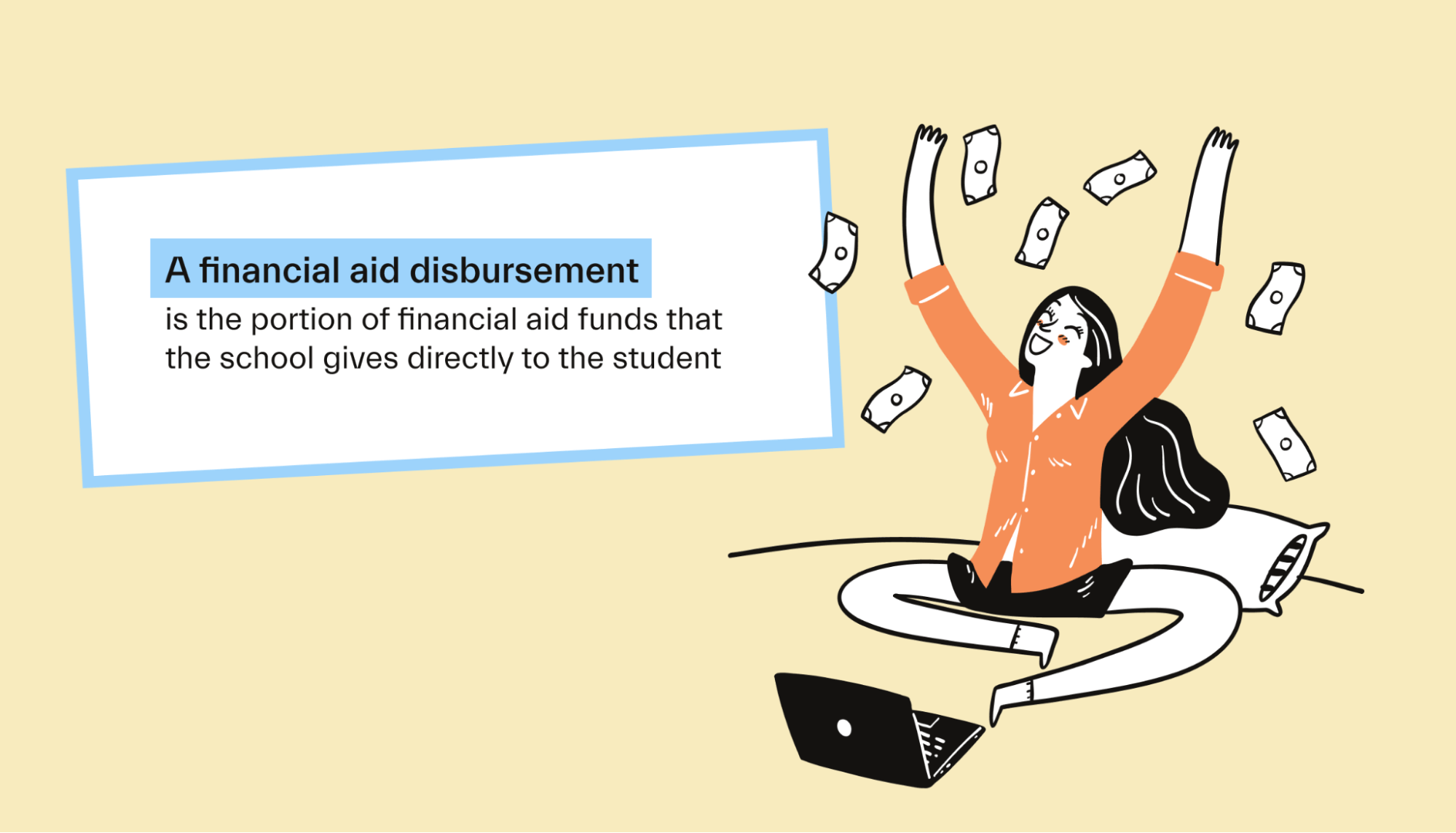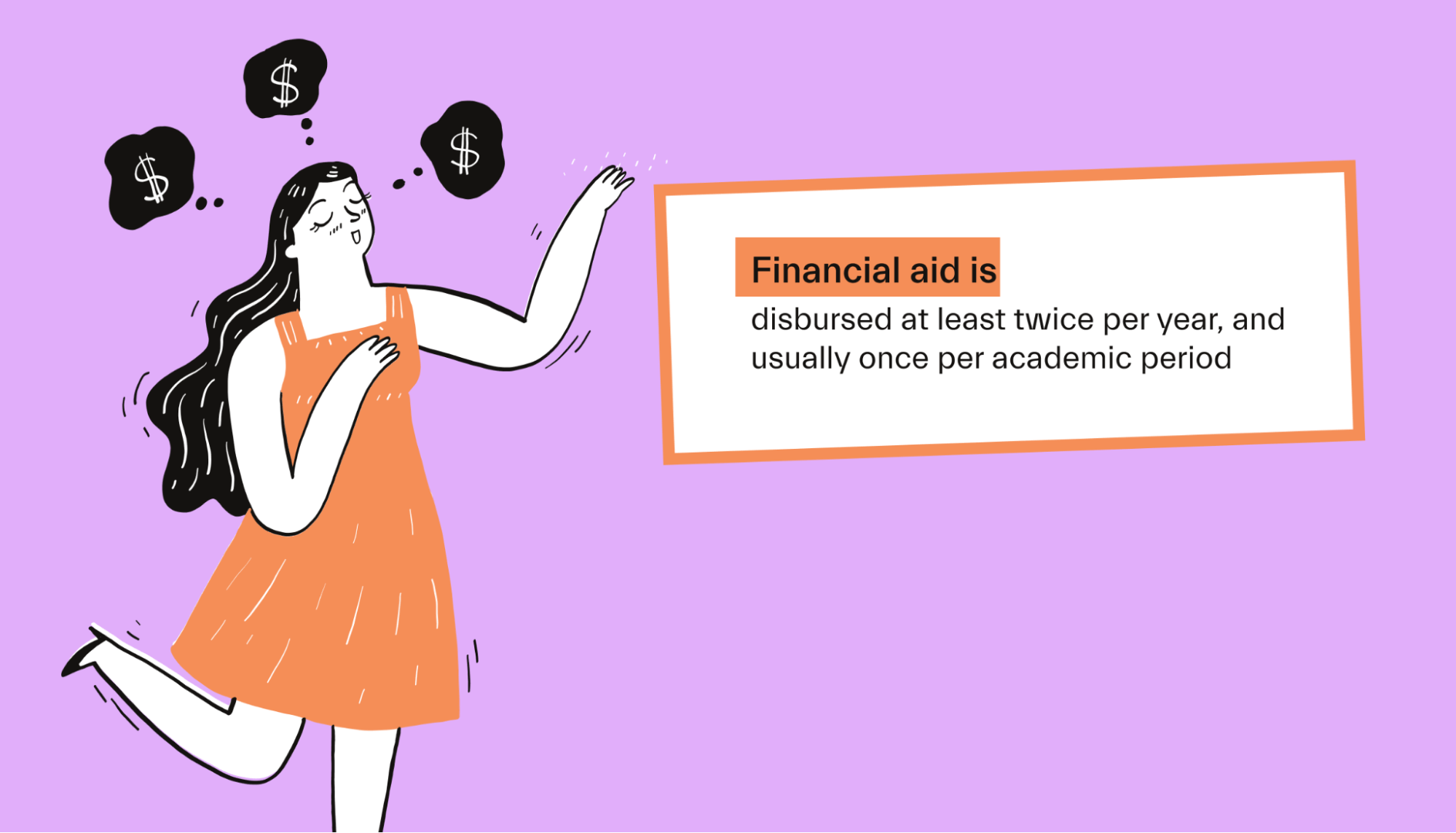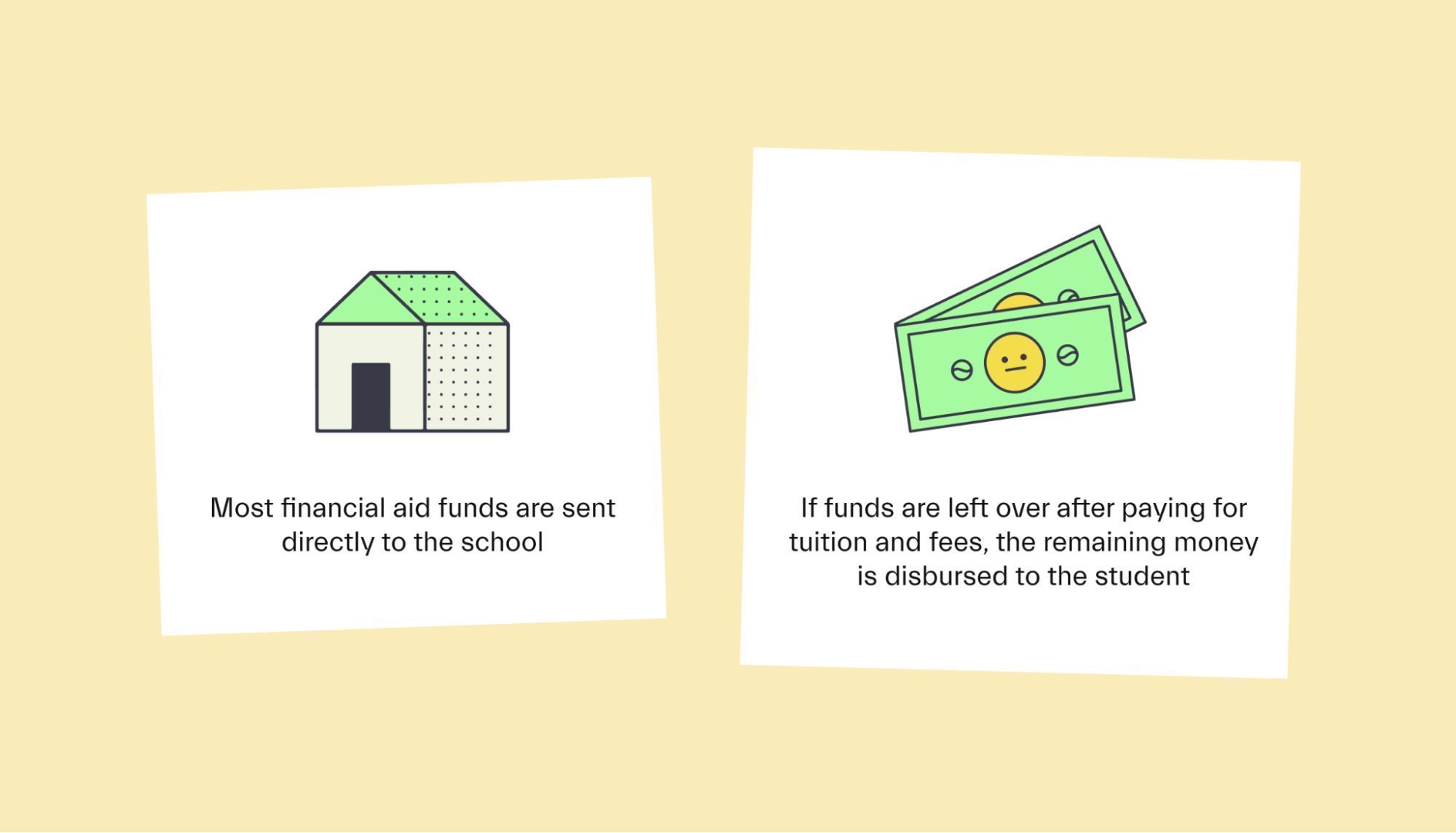Financial aid •
February 18, 2023
How financial aid disbursement works
Disbursement is the payment of financial aid funds to the student directly from the school. Here’s how financial aid disbursement works.

When it comes to financial aid, we hear a lot about applying for it. Don’t forget to submit your FAFSA! Be sure to know the due date! Apply early for the best odds!
But we don’t hear much about receiving financial aid—the nitty-gritty of the actual distribution of financial assistance. This process is called financial aid disbursement, and it can be confusing.
This guide is here to set things straight. We’ll cover how financial aid is disbursed, where funds are sent, and what this means for you, the student!
What is financial aid?
First, let’s refresh our memory on how financial aid works.
Financial aid includes student loans, grants, work-study, and certain scholarships. Over 85% of students receive some sort of aid.
The process of getting financial aid looks like this:
The student files the FAFSA each academic year.
The Department of Education reviews the student’s information, finances, and expected family financial support.
Financial aid awards are calculated based on financial need.
Money is sent directly to the school that the student is attending.
The school applies the funds to the student’s tuition, fees, and room and board costs.
Any leftover money is then distributed to the student to be used for living expenses.
The “leftover money” from Step 6 is known as financial aid disbursement.
What is financial aid disbursement?
“Disbursement” is a fancy word for payment. So, a financial aid disbursement is simply a payment of financial aid funds made to a student.
More specifically, a financial aid disbursement is a payment of funds made to the student from the school the student attends.
How much disbursement can a student receive?
Financial aid award amounts vary significantly; some students won’t have any money disbursed.
For instance, if a student is approved for $5,000 worth of aid but has $6,000 per quarter of tuition, room and board, and other school expenses, they won’t get a disbursement. In this case, they’ll need to come up with $1,000 to cover the rest of their required costs.

What can I spend my disbursement on?
Financial aid disbursements are generally intended to be used for college expenses. These might include living expenses, like food, rent, or textbooks.
That said, students have flexibility with what they use disbursements for. Once the money is given to the student, they can technically do whatever they please.
When is financial aid disbursed?
Financial aid is managed mainly by schools. Each school has its own process for collecting and disbursing financial aid funds.
So, to know precisely when your financial aid will be disbursed, you’ll need to contact your school’s financial assistance office (though many schools also publish disbursement dates on their websites).
While the details do vary by school, there are some general timelines you can use to get a bigger picture of the process:
The Department of Education requires schools to distribute aid at least twice per year.
Many schools disburse aid at least once per academic period (quarter, semester, or trimester). Some may pay out even more frequently—twice per academic period, for instance.
Aid funds are typically awarded shortly before the start of the academic period. Most schools distribute aid at least 10 days before the beginning of the quarter or semester.

Though, again, the only way to know the exact date you can expect to receive your disbursement is to contact your school or look up its financial aid disbursement dates online.
What might delay disbursement?
Various things might slow down, delay, or even prevent financial aid disbursement. Here are some things to look out for.
30-day delay for first-year undergrad borrowers
There might be a 30-day delay for first-year undergrads to receive student loan funds. However, this delay only applies to the first time the student borrows funds.
Failure to complete student loan entrance counseling
Student loan funds might be delayed if a student doesn’t complete entrance counseling. Entrance counseling is a program designed to help students understand the terms of their loans and how those terms will affect their future finances. It’s required for new borrowers.
Missed deadlines
Missing mandatory deadlines to file paperwork can also delay disbursement—or even prevent a student from being eligible for aid. For example, suppose the student misses the FAFSA deadline, which, in most cases, would eliminate their chance of getting aid for that academic year.
Schools may require additional documentation to confirm aid eligibility—so keep a close eye out for communication from your school. And, at the risk of sounding like a broken record, check in with your school’s financial aid office if you have any questions!
Where are financial aid disbursements sent?
How is aid money actually distributed?
Disbursement can happen in several ways.
For example, the money might be applied to the student’s school account (for on-campus expenses) or transferred to the student via a check or bank transfer.
The type of aid also affects how it’s distributed. Here’s an overview.
Grants
Grants are awarded to select students who demonstrate financial need. Unlike loan funds, grants don’t need to be paid back.
Federal grants are sent directly to the school and applied to tuition and related expenses. If there are any funds left over, they may be disbursed to the student.
Student loans
Student loans are available to most students, regardless of their financial need. Loans must be paid back, however—with interest.

The money is sent directly to the school for federal loans and applied to the student’s expenses. From there, leftover funds are sent directly to the student.
In the case of Parent PLUS Loans, the remaining funds may be sent to the student’s parents.
Work-study
Work-study is a unique type of financial aid that allows students to get part-time jobs on or near campus to earn money. Federal work-study is awarded to students via the FAFSA, but it must be completed through an approved employer.
Work-study aid still flows through your school.
Money that a student earns at a work-study job will be sent to the school. The school will pay that money to the student. Or the student can request that the funds be applied to their future expenses (tuition, fees, etc.).
Participating in work-study is optional. Being awarded a work-study aid package doesn’t mean you’ll receive that money automatically—it just means that you can find work with a work-study-approved employer to earn some extra cash.
Scholarships
Scholarships are free money for college that can be merit-based (awarded based on athletic ability or academic excellence) or awarded based on a student’s financial need. Most scholarships are not part of the FAFSA process and are instead applied for separately.
Scholarship money can be sent to the school or directly to the student—it depends on the details of the scholarship. Some cash scholarships are issued as a check, while others are only valid for tuition and other educational expenses.
Hint: Want to earn free money for school that doesn’t need to be paid back? Read through our guide to landing a scholarship.
Private student loans
Private student loans are offered by banks and private lenders. They are NOT part of the FAFSA process. Students can apply directly with banks to get private student loans. They require a credit check and a detailed loan application.

Most private student loans are sent directly to the school and applied to mandatory costs. Then, the leftover funds are distributed to the student. Private loans are like standard federal student loans in that way—but the application process is different.
Can I get help before financial aid is disbursed?
Sometimes, students find themselves with expenses that need to be paid before financial aid money is disbursed. Examples include living expenses over the summer or a new laptop for school.
In most cases, students will need to wait for the standard financial aid disbursements—which typically come right around the time classes start.
However, certain schools may have some aid money to help with early expenses. However, this money is often reserved for lower-income students (some schools don’t have any extra cash available).
Likewise, some schools may offer emergency student loans—loans that are generally used for unexpected events, like a job loss or a death in the family. Again, your school’s financial aid officers can help explain more about how these emergency loans work.
If the school can’t help, other options might include a cash advance or a short-term personal loan.
Conclusion
Financial aid disbursement is the process of your financial aid funds being paid directly to you. It generally happens after applicable funds have been applied to your tuition and fees. Aid is usually disbursed at least once per term (semester, quarter, or trimester).
From FAFSA to filing appeals, you can do the financial aid stuff on your own. Want an expert to take over? That's cool too--and where Mos financial aid advisors come in. Work 1-on-1 with an advisor who’ll review your annual aid offer, draft custom tuition negotiation letters, and more. Explore Mos memberships to get started.
The Mos blog is a treasure trove of helpful information about budgeting, paying for college, navigating the FAFSA, and much more.
Let's get
your money
- Get paired with a financial aid expert
- Get more money for school
- Get more time to do you







